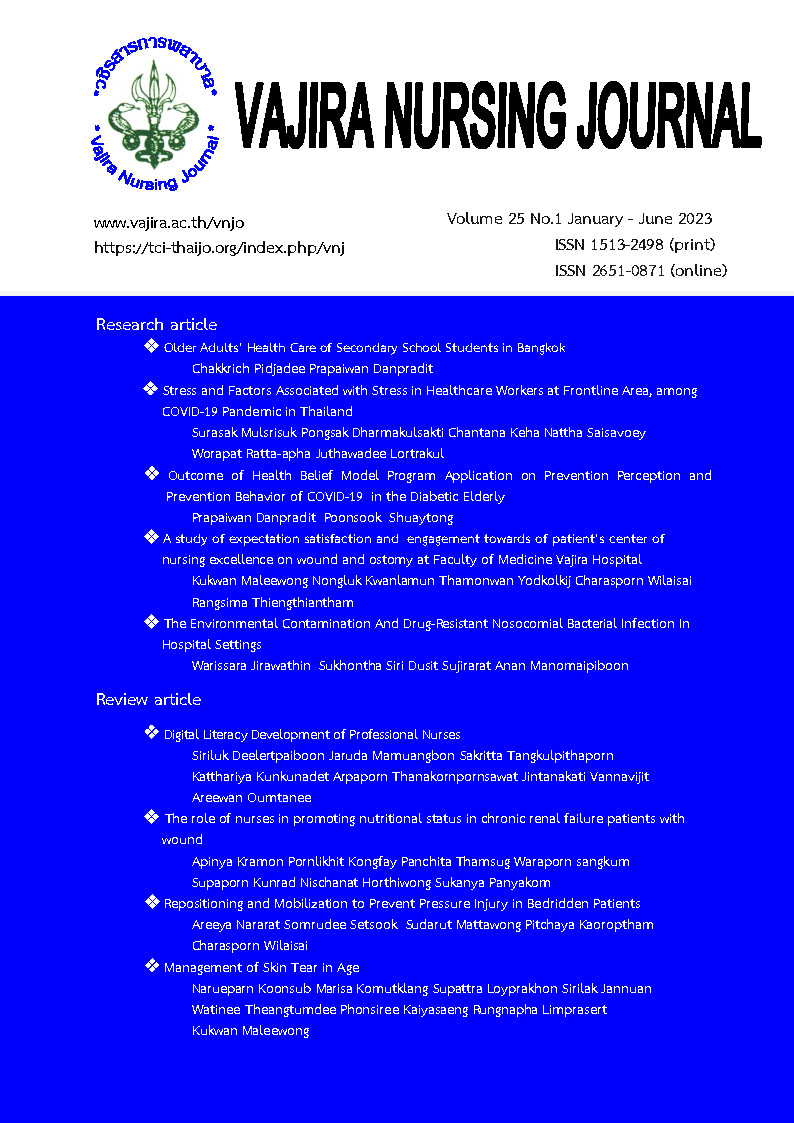การเปลี่ยนท่าและการเคลื่อนไหวร่างกาย เพื่อป้องกันการเกิดแผลกดทับในผู้ป่วยติดเตียง
Main Article Content
บทคัดย่อ
แผลกดทับ เป็นภาวะแทรกซ้อนที่มักพบได้บ่อยในผู้ป่วยที่มีข้อจำกัดในการเคลื่อนไหว ไม่สามารถช่วยเหลือตัวเองได้ ต้องอยู่บนเตียงตลอดเวลา สาเหตุสำคัญเกิดจากเนื้อเยื่อขาดเลือดจากแรงกดทับเป็นเวลานาน แรงเฉือน แรงเสียดทานจากการพลิกตัวหรือการเลื่อนผู้ป่วย เมื่อผู้ป่วยมีแผลกดทับจะมีความเจ็บปวด และทุกข์ทรมาน การเปลี่ยนท่า และการเคลื่อนไหวร่างกายเป็นกลยุทธ์ในการป้องกันการเกิดแผลกดทับ โดยการลดระยะเวลาของแรงกดบนเนื้อเยื่อ เพื่อลดการขาดออกซิเจนของเนื้อเยื่อซึ่งเป็นการป้องกันการเกิดแผลกดทับที่สามารถทำได้ง่าย ผู้ดูแล และผู้ป่วยสามารถปฏิบัติได้ด้วยตนเอง อีกทั้งยังสามารถช่วยลดค่าใช้จ่ายในการดูแล และเพิ่มคุณภาพชีวิตที่ดีขึ้น
Article Details

อนุญาตภายใต้เงื่อนไข Creative Commons Attribution-NonCommercial-NoDerivatives 4.0 International License.
เนื้อหาและข้อมูลในบทความที่ลงตีพิมพ์ในวชิรสารการพยาบาลถือเป็นข้อคิดเห็นและความรับผิดชอบของผู้เขียนบทความโดยตรง ซึ่งกองบรรณาธิการไม่จำเป็นต้องเห็นด้วย หรือร่วมรับผิดชอบใด ๆ ทั้งสิ้น
บทความ ข้อมูล เนื้อหา รูปภาพ ฯลฯ ที่ได้รับการตีพิมพ์ในวชิรสารการพยาบาล ถือเป็นลิขสิทธิ์ของวชิรสารการพยาบาล หากบุคคลใดหรือหน่วยงานใดต้องการนำทั้งหมดหรือส่วนหนึ่งส่วนใดไปเผยแพร่ต่อหรือเพื่อกระทำการใด ๆ จะต้องได้รับอนุญาตเป็นลายลักอักษรจากวชิรสารการพยาบาลก่อนเท่านั้น
เอกสารอ้างอิง
เทพนารี กว้างเงิน, จารุวรรณ เวชพันธ์, วรรณิภา อำนาจวิชญกุล. การป้องกันการเกิดแผลกดทับ. กรุงเทพฯคณะแพทยศาสตร์ศิริราชพยาบาล มหาวิทยาลัยมหิดล; 2561. ฝ่ายการพยาบาล โรงพยาบาลศิริราช. เข้าถึงได้จาก https://www.si.mahidol.ac.th/th/division/hph/ admin/news_ files/660_49_1.pdf.
Duvall J, Karg P, Brienza D, Pearlman J. Detection and classification methodology for movements in the bed that supports continuous pressure injury risk assessment and repositioning compliance. Journal of Tissue Viability [Internet]. 2019 Feb 1 [cited 2023 Jun 2]; 28(1): 7–13. Available from: https:// discovery.ebsco.com/ linkprocessor/ plink?id=2628eb07-a645-39fd-9dd4-327d 09 28924a.
ผกามาศ พีธรากร. การพยาบาลผู้ป่วยที่มีแผลกดทับโดยใช้หลักฐานเชิงประจักษ์:บทบาทพยาบาล. หัวหินเวชสาร 2564; 1. เข้าถึงได้จาก https://he01.tcithaijo.org/index.php/ hhsk/article/ download/243868 /168454/ 905635.
พิศมัย บุติมาลย์, แสงอรุณ อิสระมาลัย, เพลินพิศ ฐานิวัฒนานนท์. การพัฒนาแนวปฏิบัติทางการพยาบาลเพื่อป้องกันภาวะแทรกซ้อนสำหรับผู้สูงอายุกลุ่มติดเตียงที่บ้าน. วารสารสงขลานครินทร์ 2561; 38: 79-91. เข้าถึงได้จากhttps://www.nur.psu.ac.th/ researchdb/file_warasarn/14307journal2.pdf.
รุจาภา เจียมธโนปจัย, สุวิมล แสนเวียงจันทร์. แนวปฏิบัติทางการพยาบาลในการป้องกันแผลกดทับวารสารพยาบาล 2561; 67(4): 53-61.
สิรินทร ฉันศิริกาญจน, ศิริพันธ์ุ สาสัตย์, สันติ ลาภเบญจกุล, อัญญพร สุทัศน์วรวุฒิ, ศุภลักษณ์ เข็มทอง, นายสมคิด เพื่อนรัมย์. คู่มือการดูแลระยะยาว (Long Term Care) สำหรับทีมหมอครอบครัว.กรุงเทพฯ: บริษัท ไซเบอร์พริ้นท์ กรุ๊ป จำกัด.
Duvall J, Karg P, Brienza D, Pearlman J. Detection and classification methodology for movements in the bed that supports continuous pressure injury risk assessment and repositioning compliance. Journal of Tissue Viability [Internet]. 2019 Feb 1 [cited 2023 Jun 2]; 28(1): 7–13. Available from: https:// discovery.ebsco.com/linkprocessor/ plink?id=2628eb07-a645-39fd-9dd4-327d09 28924a.
Edsberg LE, Black JM, Goldberg M, McNichol L, Moore L, Sieggreen M. Revised National Pressure Ulcer Advisory Panel Pressure Injury Staging System: Revised Pressure Injury Staging System. J Wound Ostomy Continence Nurs. 2016; 43(6): 585-597.
European Pressure Ulcer Advisory Panel, National Pressure Injury Advisory Panel และ Pan Pacific Pressure Injury Alliance.การป้องกันและรักษาแผลกดทับ: แนวปฏิบัติอ้างอิงฉบับย่อ. Emily Haesler (Ed.). EPUAP/NPIAP/PPPIA: 2019. https://www.epuap.org/wp-content/ uploads/2021/04/qrg-2019-thai-04-21.pdf
Gillespie BM, Walker RM, Latimer SL, Thalib L, Whitty JA, McInnes E, et al. Repositioning for pressure injury prevention in adults: An abridged Cochrane systematic review and meta-analysis. International Journal of Nursing Studies [Internet]. 2021 Aug 1 [cited 2023 Jun 2]; 120. Available from:https://discovery.ebsco.com/linkprocessor/plink?id=b9b01f35-58c9-3faa-a2d8-3a2e44ccbbdd.
Zhang H, Ma Y, Wang Q, Zhang X, Han L. Journal of Tissue Viability. 2022; 31(1): 142-151.
National Pressure Injury Advisory Panel. Pressure Injury Stages. 2020. https://npiap.com/page/PressureInjuryStages.Last accessed August 19, 2020.
Neves H, Cruz A, Bernardes RA, Cardoso R, Pimentel M, Duque FM, et al. Ablefit: Development of anAdvanced System for ehabilitation.Biomedinformatics 2023; 3, 164–176.
Smart DA, Dermody G, Coronado ME, Wilson M. Mobility Programs for the Hospitalized Older Adult: A Scoping Review. Gerontol Geriatr Med. 2018; 4:23-33.
Tracey L. Yap, Susan M. Kennerly, Susan D. Horn, Nancy Bergstrom, Santanu Datta, Cathleen Colon-Emeric. TEAM-UP for quality: a cluster randomized controlled trial protocol focused on preventing pressure ulcers through repositioning frequency and precipitating factors. BMC Geriatrics [Internet]. 2018 Feb 1 [cited 2023 Jun 2];18(1):1–15. Available from: https://discovery.ebsco. com/linkprocessor/ plink?id=b877c7ae-694d-363c-a9cb-10d552201ff4.


